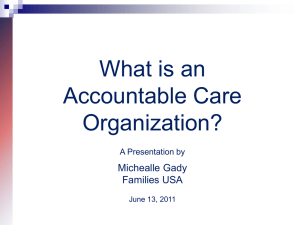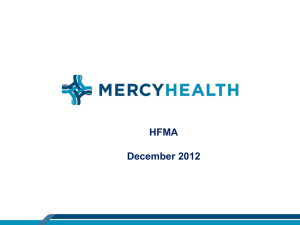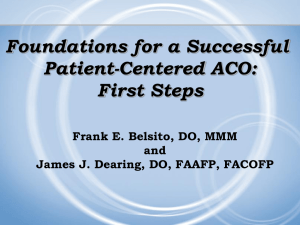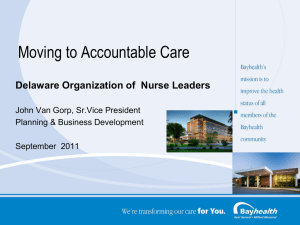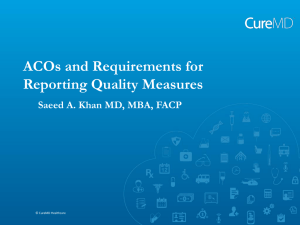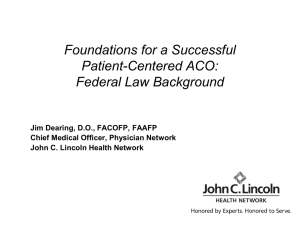GPRO Audit- What this means for your practice?
advertisement
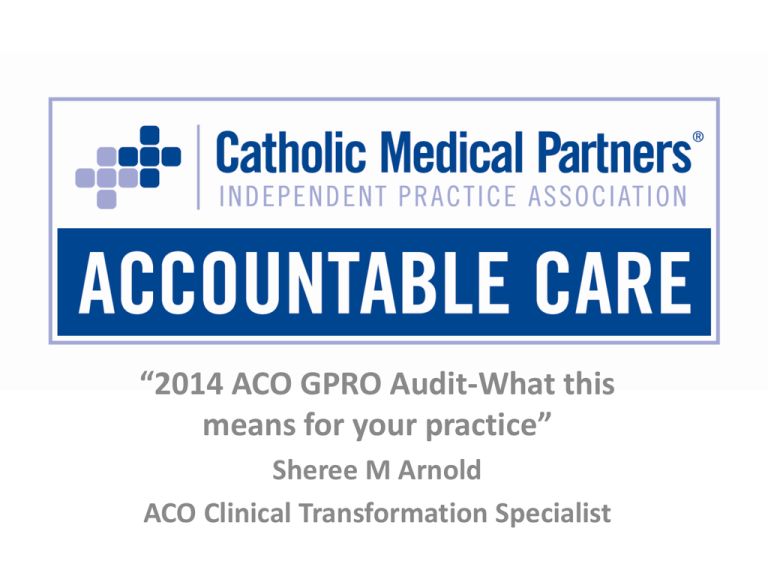
“2014 ACO GPRO Audit-What this means for your practice” Sheree M Arnold ACO Clinical Transformation Specialist Agenda • Catholic Medical Partners ACO overview • Attribution and sampling of patients • ACO quality measures ©2011 Proprietary and Confidential Catholic Medical Partners ACO Overview • • 3-year contract with Medicare for Medicare Shared Savings Program Made up of providers who voluntarily agree to work together to coordinate care for patients while meeting certain quality standards to share in any savings they achieve for the Medicare program. • – 273 participating practices – 860 primary and specialty providers (188 primary care physicians & 672 specialty care physicians) – The ACO has the following institutional providers: Catholic Health Hospitals, Mt. St. Mary’s Hospital and Health Centers, Bertrand Chaffee Hospital, Bry- Lin Behavioral Health System Take care of a defined population of patients – Medicare FFS beneficiaries only – ~25,400 ©2011 Proprietary and Confidential ACO GPRO Attribution • • • CMS assigns a Medicare beneficiary to Shared Savings Program ACO based on current program rules – Beneficiaries are assigned to the Shared Savings Program ACO if they: Have at least one month of Part A and Part B enrollment – Do not have any months of Medicare group (private) health plan enrollment (i.e., Medicare Advantage) – Reside in the United States or U.S. territories and possessions – Have a primary care service with a provider at the ACO • Have the largest share of their primary care services (by Medicare allowed charges) provided by the participating ACO , defined as: Step (1): having more primary care services furnished by primary care physicians at the participating ACO than furnished by primary care physicians at any other entity; or • Step (2): (for those beneficiaries who have not received any primary care services from a primary care physician) having at least one primary care service furnished by specific types of physicians and had more primary care services furnished by professionals at the participating ACO than at any other entity (Participating Specialist) Timing of attribution: Shared Savings Program ACO attribution: Use beneficiaries attributed for the 2014 3rd quarter report A patient attributed in one year of Shared Savings Program ACO may or may not be attributed to the ACO in the following reporting years ©2011 Proprietary and Confidential ACO GPRO Sampling • • • CMS analyzes Medicare claims submitted and captured in the Integrated Data Repository (IDR) from January 1, 2014 through October 31, 2014 (i.e., sampling period) Patients are sampled using a methodology that increases the likelihood of patients being sampled into multiple modules Assigned/Aligned beneficiaries who meet additional quality eligibility criteria may be sampled into GPRO Web Interface modules through a three-step process described in the following slides ©2011 Proprietary and Confidential Attribution and Sampling Overview • The GPRO Reporting requires ACOs to report data on a pre-determined population of patients • Beneficiaries are attributed to the ACO • Attributed beneficiaries are assessed for quality measurement eligibility and then randomly sampled based on measurement and disease criteria. • Sample is used for quality reporting ©2011 Proprietary and Confidential ACO QUALITY MEASURES ACO Quality Measures • Goal = 90th percentile Domain Measure Description Patient/Caregiver Experience Patient/Caregiver Experience Patient/Caregiver Experience Patient/Caregiver Experience Patient/Caregiver Experience Patient/Caregiver Experience Patient/Caregiver Experience Care Coordination/Patient Safety Care Coordination/Patient Safety Care Coordination/Patient Safety Care Coordination/Patient Safety Care Coordination/Patient Safety Care Coordination/Patient Safety ACO #1 ACO #2 ACO #3 ACO #4 ACO #5 ACO #6 ACO #7 ACO #8 ACO #9 ACO #10 ACO #11 ACO #12 ACO #13 Getting Timely Care, Appointments, and How Well Your Doctors Communicate Patients’ Rating of Doctor Access to Specialists Health Promotion and Education Shared Decision Making Health Status/Functional Status Risk Standardized, All Condition Readmissions ASC Admissions: COPD or Asthma in Older Adults ASC Admission: Heart Failure Percent of PCPs who Qualified for EHR Incentive Medication Reconciliation Falls: Screening for Fall Risk ©2011 Proprietary and Confidential 90th perc. 90 90 90 90 60.71 76.71 N/A 15.45 0 0.18 90.91 90 73.38 ACO Quality Measures cont. • . Domain Preventive Preventive Preventive Preventive Preventive Preventive Preventive Measure Health Health Health Health Health Health Health Preventive Health At-Risk Population Diabetes At-Risk Population Diabetes At-Risk Population Hypertension At-Risk Population IVD At-Risk Population IVD At-Risk Population HF At-Risk Population CAD ©2011 Proprietary and Confidential ACO #14 ACO #15 ACO #16 ACO #17 ACO #18 ACO #19 ACO #20 Description Influenza Immunization Pneumococcal Vaccination Adult Weight Screening and Follow-up Tobacco Use Assessment and Cessation Depression Screening Colorectal Cancer Screening Mammography Screening Proportion of Adults who had blood pressure ACO #21 screened in past 2 years ACO #22. Hemoglobin A1c Control (HbA1c) (<8 Diabetes percent) ACO #23. Low Density Lipoprotein (LDL) Composite ACO (<100 mg/dL) ACO #24. Blood Pressure (BP) < #22 – 26 140/90 ACO #25. Tobacco Non Use ACO #26. Percent of beneficiaries with diabetes whose ACO #27 HbA1c in poor control (>9 percent) ACO #28 Percent of beneficiaries with hypertension Percent of beneficiaries with IVD with complete ACO #29 lipid profile and LDL control < 100mg/dl Percent of beneficiaries with IVD who use ACO #30 Aspirin or other antithrombotic ACO #31 Beta-Blocker Therapy for LVSD ACO #32. Drug Therapy for Lowering LDL CAD Composite Cholesterol ACO #33. ACE Inhibitor or ARB ACO #32 – 33 Therapy for Patients with CAD and Diabetes 90th perc. 100 100 100 90 51.81 100 99.56 90 36.5 10 79.65 78.81 97.91 90 79.84 CARE-1: Medication Reconciliation Measure Description • Percentage of patients aged 65 years and older discharged from any inpatient facility (e.g., hospital, skilled nursing facility, or rehabilitation facility) and seen within 30 days following discharge in the office by the physician providing on-going care who had a reconciliation of the discharge medications with the current medication list in the outpatient medical record documented Guidance • This measure is reported for each discharge found for the patient • The practice may verify the discharge date if evidence of hospitalization or discharge is found in the record within 1-2 days of the pre-populated discharge date ©2011 Proprietary and Confidential CARE-2: Falls: Screening for Future Fall Risk Measure Description • Percentage of patients aged 65 years and older who were screened for future fall risk at least once during the measurement period Guidance • Screening for future fall risk must include: Documentation of no falls in the past year or only one fall without injury in the past year or documentation of two or more falls in the past year or any fall with injury in the past year ©2011 Proprietary and Confidential Diabetes Mellitus (DM) Module • The Diabetes Mellitus (DM) Module contains one measure and one composite measure made up of five component measures: DM-2: Percentage of patients aged 18 through 75 years with diabetes who had most recent hemoglobin A1c greater than 9.0% – Optimal Diabetes Care (All or Nothing Scoring) DM-13: Diabetes Mellitus: High Blood Pressure Control – DM-14: Diabetes Mellitus: Low Density Lipoprotein (LDL-C) Control – DM-15: Diabetes Mellitus: Hemoglobin A1c Control (< 8%) – DM-16: Diabetes Mellitus: Daily Aspirin or Antiplatelet Medication Use for Patients with Diabetes and Ischemic Vascular Disease – DM-17: Diabetes Mellitus: Tobacco Non-Use ©2011 Proprietary and Confidential HF-6: Heart Failure: Beta-Blocker Therapy for Left Ventricular Systolic Dysfunction (LVSD) Measure Description • Percentage of patients aged 18 years and older with a diagnosis of heart failure (HF) with a current or prior left ventricular ejection fraction (LVEF) < 40% who were prescribed beta-blocker therapy either within a 12 month period when seen in the outpatient setting OR at each hospital discharge Guidance • If the patient has ever had an LVEF < 40% or a documented LVEF as moderate or severe answer “Yes” to the presence of LVSD • Bisoprolol, carvedilol, or sustained release metoprolol succinate are the ONLY beta-blockers allowed for this measure ©2011 Proprietary and Confidential PREV-5: Breast Cancer Screening Measure Description • Percentage of women 50 through 74 years of age who had a mammogram to screen for breast cancer within 27 months Guidance • Screening includes breast imaging, breast x-ray, diagnostic mammography, digital mammography, mammogram, screening mammography ©2011 Proprietary and Confidential PREV-6: Colorectal Cancer Screening Measure Description • Percentage of patients aged 50 through 75 years who received the appropriate colorectal cancer screening Guidance • FOBT includes ColoCARE, Coloscreen, EZ Detect, Fecal occult blood test, flushable reagent pads, flushable reagent stool blood test, guaiac smear test, Hemoccult, Seracult, stool occult blood test, FIT • Colorectal screening does not include: virtual colonoscopy, Barium enema, or Colovantage • Patient refusal is not a reason to exclude ©2011 Proprietary and Confidential PREV-9: Preventive Care and Screening: Body Mass Index (BMI) Screening and Follow-Up Measure Description • Percentage of patients aged 18 years and older with a documented BMI during the encounter or during the previous six months AND when the BMI is outside of normal parameters, a follow-up plan is documented during the encounter or during the previous six months of the encounter • Normal Parameters: Age 65 years and older BMI ≥ 23 and < 30 • Age 18 – 64 years BMI ≥ 18.5 and < 25 Guidance • Follow-up may include, but is not limited to: documentation of education, referral (such as, a registered dietician, nutritionist, occupational therapist, physical therapist, primary care provider, exercise physiologist, mental health professional, or surgeon), pharmacological interventions or dietary supplements, exercise counseling or nutrition counseling • Follow-up plan is not required for normal BMI ©2011 Proprietary and Confidential PREV-11: Screening for High Blood Pressure and Follow-Up Documented Measure Description • Percentage of patients aged 18 years and older seen during the measurement period who were screened for high blood pressure AND a recommended follow-up plan is documented based on the current blood pressure reading as indicated Guidance • Patients with a Medicare claim indicating a history of hypertension prior to the first day of the measurement period (1/1/2014) will not be included in your sample for this measure • A normal blood pressure reading (<120 systolic and < 80 diastolic) requires no documentation of follow-up • Recommended follow-up based on BP classification includes: recommending screening interval follow-up, lifestyle modifications, referrals to alternative/primary care provider, antihypertensive pharmacological therapy, laboratory tests, or an electrocardiogram • Need to link the recommended follow-up to the elevated blood pressure using guidance provided ©2011 Proprietary and Confidential PREV-12: Preventive Care and Screening: Screening for Clinical Depression and Follow-Up Plan Measure Description • Percentage of patients aged 12 years and older screened for clinical depression on the date of the encounter using an age appropriate standardized depression screening tool AND if positive, a follow-up plan is documented on the date of the positive screen Guidance • Screening includes completion of a clinical or diagnostic tool used to identify people at risk of developing or having a certain disease or condition even in the absence of symptoms • This measure requires the screening to be completed in the office of the provider filing the code • Follow-up plan may include a proposed outline of treatment to be conducted as a result of positive clinical depression screening • Use a normalized and validated depression screening tool developed for the patient population where it is being utilized. Examples of depression screening tools include but are not limited to: Adolescent Screening Tools (12-17 years) • Patient Health Questionnaire for Adolescents (PHQ-A), Beck Depression Inventory-Primary Care Version (BDI-PC), Mood Feeling Questionnaire, Center for Epidemiologic Studies Depression Scale (CES-D) and PRIME MD-PHQ-2 ©2011 Proprietary and Confidential What’s next… • • • • GPRO starting! January-March 2015 Keep eye out for charts reviews Weekly Q&A Conference line-March2015 Questions? Please contact Sheree Arnold (716)862-2453 or David Nielsen (716)862-2161 ©2011 Proprietary and Confidential
